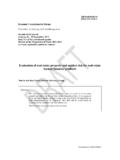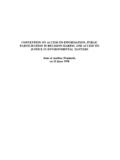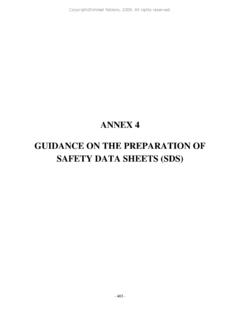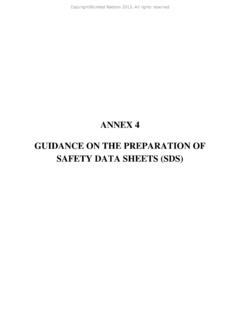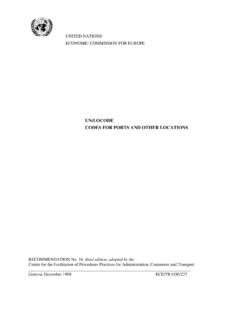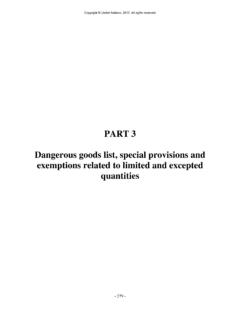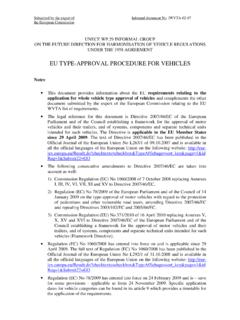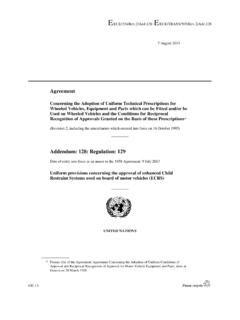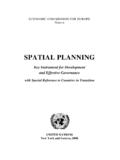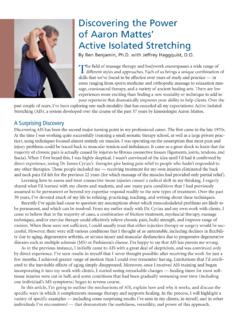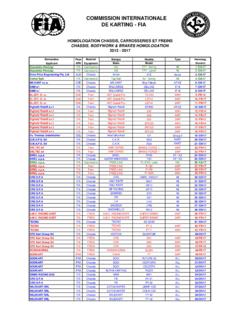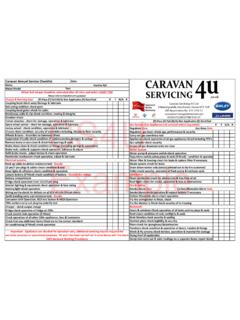Transcription of Agreement - UNECE
1 Agreement Concerning the Adoption of Uniform Technical Prescriptions for Wheeled Vehicles, Equipment and Parts which can be Fitted and/or be Used on Wheeled Vehicles and the Conditions for Reciprocal Recognition of Approvals Granted on the Basis of these Prescriptions (Revision 2, including the amendments which entered into force on 16 October 1995) _____ Addendum 45: Regulation No. 46 Revision 5 Incorporating all valid text up to: Supplement 1 to the 03 series of amendments - Date of entry into force: 18 November 2012 04 series of amendments - Date of entry into force: 15 July 2013 Uniform provisions concerning the approval of devices for indirect vision and of motor vehicles with regard to the installation of these devices _____ UNITED NATIONS Former title of the Agreement : Agreement Concerning the Adoption of Uniform Conditions of Approval and Reciprocal Recognition of Approval for Motor Vehicle Equipment and Parts, done at Geneva on 20 March 1958.
2 E/ECE/324 E/ECE/TRANS/505 19 August 2013 E/ECE/324 E/ECE/TRANS/505 3 Regulation No. 46 Uniform provisions concerning the approval of devices for indirect vision and of motor vehicles with regard to the installation of these devices Contents Page 1. Scope .. 5 I. Devices for indirect vision 2. Definitions .. 5 3. Application for approval .. 8 4. Markings .. 8 5. Approval .. 8 6. Requirements .. 9 7. Modification of the type of device for indirect vision and extension of approval .. 19 8. Conformity of production .. 20 9. Penalties for non-conformity of production .. 20 10. Production definitively discontinued .. 20 11. Names and addresses of Technical Services responsible for conducting approval tests, and of Type Approval Authorities .. 20 II. Installation of devices for indirect vision 12. Definitions .. 21 13. Application for approval .. 22 14. Approval .. 22 15. Requirements .. 22 16. Modifications of the vehicle type and extension of approval.
3 39 17. Conformity of production .. 40 18. Penalties for non-conformity of production .. 40 19. Production definitively discontinued .. 40 20. Names and addresses of Technical Services responsible for conducting approval tests, and of Type Approval Authorities .. 40 21. Transitional provisions .. 40 E/ECE/324 E/ECE/TRANS/505 4 Annexes 1 Information document for type approval of a device for indirect vision .. 43 2 Information document for type approval of vehicle with respect to the installation of devices for indirect vision .. 44 3 Communication concerning the approval or refusal or extension or withdrawal of approval or production definitively discontinued of a type of device for indirect vision, pursuant to Regulation No. 46 .. 46 4 Communication concerning the approval or refusal or extension or withdrawal of approval or production definitively discontinued of a type of vehicle with regard to the mounting of devices for indirect vision, pursuant to Regulation No.
4 46 .. 48 Appendix .. 49 5 Arrangement of approval mark for a device for indirect vision .. 50 6 Test method for determining reflectivity .. 51 7 Procedure for determining the radius of curvature "r" of the reflecting surface of a mirror .. 57 8 Procedure for determining the "H" point and the actual torso angle for seating positions in motor vehicles .. 59 Appendix 1 - Description of the three-dimensional "H" point machine (3-D H machine) .. 59 Appendix 2 - Three-dimensional reference system .. 59 Appendix 3 - Reference data concerning seating positions .. 59 9 (Reserved) .. 60 10 Calculation of the detection distance .. 61 11 Determination of the displayed object size .. 64 E/ECE/324 E/ECE/TRANS/505 5 1. Scope This Regulation applies: (a) To compulsory and optional devices for indirect vision, set out in the table under paragraph of this Regulation for vehicles of category M and N1 and to compulsory and optional devices for indirect vision mentioned in paragraphs and of this Regulation for vehicles of category L1with bodywork at least partly enclosing the driver; (b) To the installation of devices for indirect visions on vehicles of categories M and N and on vehicles of category L1 with bodywork at least partly enclosing the driver.
5 I. Devices for indirect vision 2. Definitions For the purposes of this Regulation: "Devices for indirect vision" means devices to observe the traffic area adjacent to the vehicle which cannot be observed by direct vision. These can be conventional mirrors, camera-monitors or other devices able to present information about the indirect field of vision to the driver. "Mirror" means any device, excluding devices such as periscopes, intended to give a clear view to the rear, side or front of the vehicle within the fields of vision defined in paragraph of this Regulation. "Interior mirror" means a device as defined in paragraph above, which can be fitted in the passenger compartment of a vehicle. "Exterior mirror" means a device as defined in paragraph above, which can be mounted on the external surface of a vehicle. "Surveillance mirror" means a mirror other than the ones defined in paragraph above which can be fitted to the inside or outside of the vehicle in order to provide fields of vision other than those specified in paragraph of this Regulation.
6 "Vision support system" means a system to enable the driver to detect and/or see objects in the area adjacent to the vehicle. "r" means the average of the radii of curvature measured over the reflecting surface, in accordance with the method described in Annex 7. "The principal radii of curvature at one point on the reflecting surface (ri)" means the values obtained with the apparatus defined in Annex 7, measured on the arc of the reflecting surface passing through the centre of this surface 1 As defined in the Consolidated Resolution on the Construction of Vehicles ( ), document ECE/ , para. 2. - E/ECE/324 E/ECE/TRANS/505 6 parallel to the segment b, as defined in paragraph of this Regulation and on the arc perpendicular to this segment. "The radius of curvature at one point on the reflecting surface (rp)" means the arithmetical average of the principal radii of curvature ri and ri : 2 i i p r' r r "Spherical surface" means a surface, which has a constant and equal radius in all directions "Aspherical surface" means a surface, which has only in one plane a constant radius.
7 "Aspherical mirror" means a mirror composed of a spherical and an aspherical part, in which the transition of the reflecting surface from the spherical to the aspherical part has to be marked. The curvature of the main axis of the mirror is defined in the x/y coordinate system defined by the radius of the spherical primary calotte with: 3 2 2 ) ( ) ( a x k x R R y R: nominal radius in the spherical part k: constant for the change of curvature a: constant for the spherical size of the spherical primary calotte "Centre of the reflecting surface" means the centre of the visible area of the reflecting surface. "The radius of curvature of the constituent parts of the mirror" means the radius "c" of the arc of the circle which most closely approximates to the curved form of the part in question. "Class of mirror" means all devices having one or more common characteristics or functions.
8 They are classified as follows: (a) Class I: "Interior rear-view mirror", giving the field of vision defined in paragraph of this Regulation; (b) Classes II and III: "Main exterior rear-view mirror", giving the fields of vision defined in paragraphs and of this Regulation; (c) Class IV: "Wide-angle exterior mirror", giving the field of vision defined in paragraph of this Regulation; (d) Class V: "Close-proximity exterior mirror", giving the field of vision defined in paragraph of this Regulation; (e) Class VI: "Front mirror", giving the field of vision defined in paragraph of this Regulation; (f) Class VII: Mirrors intended for L category vehicles with bodywork, giving the field of vision defined in paragraph of this Regulation. E/ECE/324 E/ECE/TRANS/505 7 "Camera-monitor device for indirect vision" means a device as defined in paragraph , where the field of vision is obtained by means of a camera-monitor combination as defined in paragraphs and below.
9 "Camera" means a device that renders an image of the outside world and then converts this image into a signal ( video signal). "Monitor" means a device that converts a signal into images that are rendered into the visual spectrum. "Detection" means the ability to distinguish an object from its background/surroundings at certain distance. "Luminance contrast" means the brightness ratio between an object and its immediate background/surrounding that allows the object to be distinguished from its background/surroundings. "Resolution" means the smallest detail that can be discerned with a perceptual system, perceived as separate from the larger whole. The resolution of the human eye is indicated as "visual acuity". "Critical object" means a cylindrical object with a height of m and a diameter of m. "Critical perception" means the level of perception that can just be obtained under critical conditions via the viewing system used.
10 This corresponds to the situation in which the representative scale of the critical object is multiple times larger than the smallest detail that can be perceived via the viewing system. "Field of vision" means the section of the tri-dimensional space which is monitored with the help of a device for indirect vision. Unless otherwise stated, this is based on the view on ground level offered by a device and/or devices other than mirrors. This may be limited by the relevant detection distance corresponding to the critical object. "Detection distance" means the distance measured from the centre of the lens of the camera to the point at which a critical object can just be perceived (as defined by the critical perception). (Reserved) (Reserved) "Visual spectrum" means light with a wavelength within the range of the perceptual limits of the human eyes: 380-780 nm. "Surveillance camera-monitor-recording device" means a camera and either a monitor or recording equipment other than the camera-monitor device defined in paragraph above which can be fitted to the inside or outside of the vehicle in order to provide fields of vision other than those specified in paragraph of this Regulation or to provide a security system within or around the vehicle.
